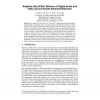Free Online Productivity Tools
i2Speak
i2Symbol
i2OCR
iTex2Img
iWeb2Print
iWeb2Shot
i2Type
iPdf2Split
iPdf2Merge
i2Bopomofo
i2Arabic
i2Style
i2Image
i2PDF
iLatex2Rtf
Sci2ools
123
click to vote
NOSSDAV
1992
Springer
1992
Springer
Adaptive, Best-Effort Delivery of Digital Audio and Video Across Packet-Switched Networks
: We present an overview of a "best-effort" transport protocol that supports conferencing with digital audio and video across interconnected packet switched networks. The protocol delivers the highest quality conference service possible given the current load in the network. Quality is defined in terms of synchronization between audio and video, the number of frames played out of order, and the end-to-end latency in the conference. High quality conference are realized through four transport and display mechanisms and a real-time implementation of these mechanisms that integrates operating system services (e.g., scheduling and resource allocation, and device management) with network communication services (e.g., transport protocols). In concert these mechanisms dynamically adapt the conference frame rate to the bandwidth available in the network, minimize the latency in the displayed streams while avoiding discontinuities, and provide quasi-reliable delivery of audio frames.
Computer Networks | End-to-end Latency | NOSSDAV 1992 | Packet Switched Networks | Transport Protocols |
| Added | 10 Aug 2010 |
| Updated | 10 Aug 2010 |
| Type | Conference |
| Year | 1992 |
| Where | NOSSDAV |
| Authors | Kevin Jeffay, Donald L. Stone, Terry Talley, F. Donelson Smith |
Comments (0)

